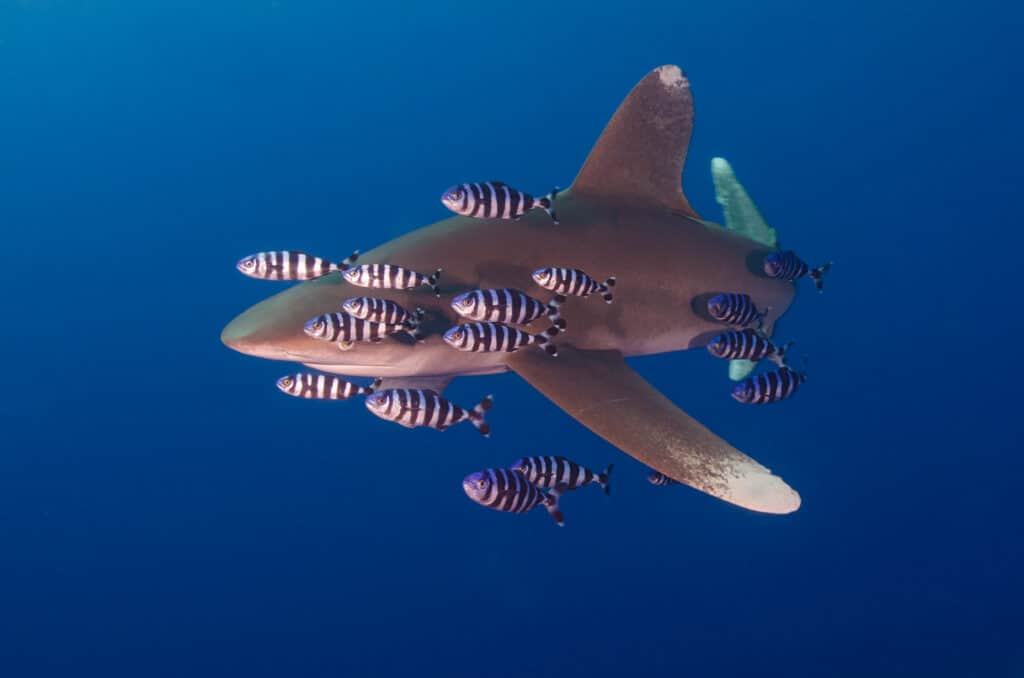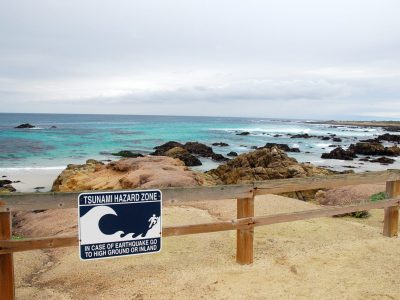Oceanic Whitetip Shark
C. longimanus
Advertisement
Oceanic Whitetip Shark Scientific Classification
- Kingdom
- Animalia
- Phylum
- Chordata
- Class
- Chondrichthyes
- Order
- Carcharhiniformes
- Family
- Carcharhinidae
- Genus
- Carcharhinus
- Scientific Name
- C. longimanus
Read our Complete Guide to Classification of Animals.
Oceanic Whitetip Shark Conservation Status
Oceanic Whitetip Shark Facts
- Diet
- Omnivore
Oceanic Whitetip Shark Physical Characteristics
- Color
- Grey
- White
- Skin Type
- Leather
- Lifespan
- Up to 25 years
- Weight
- Around 200 lbs
- Length
- Up to 13 ft
- Age of Sexual Maturity
- 10 to 15.8 years
- Venomous
- No
- Aggression
- Medium
View all of the Oceanic Whitetip Shark images!
Unlike most sharks, the oceanic whitetip shark is known for being opportunistic and aggressive.
The oceanic whitetip shark is a critically endangered species that inhabit tropical waters. They have white tips on their fins, hence the species’ name.
5 Oceanic Whitetip Shark Facts
- Aggressive: Unlike most sharks, many experts consider this species aggressive. As opportunistic hunters, they may be dangerous to humans in some situations
- Highly prized: The fins of this species are sought after by chefs and restaurants because they are a prime ingredient in shark fin soup. Because of hunting, their population has declined.
- White fins: As their name suggests, this species has white-tipped fins. This feature sets them apart from others.
- Drastically declining population: You could find this shark throughout much of the globe at one point. However, their population has declined steeply.
- Opportunistic hunter: Unlike many predators, this shark remains very opportunistic. Therefore, they will eat just about anything if they can catch it.
Oceanic Whitetip Shark Classification and Scientific Name
This shark is in the Carcharhinus genus, which contains 35 species. However, experts expect that other species have yet to be discovered.
The Oceanic whitetip shark belongs to the family of requiem sharks. These sharks are typically live-bearing in warmer seas and migratory. This family has many species, including some of the most common shark species. In total, this family includes 60 species that are grouped into 12 genera.
Finally, requiem sharks belong to the ground shark order, also known as the Carcharhiniformes. This grouping contains 270 species, making it the largest order of sharks. Many members have two dorsal fins, an anal fin, and five-gill slits.
Oceanic Whitetip Shark Appearance
This species is best known for its long, whig-like fins. On top of being white-tipped, these fins are larger than most sharks and extremely rounded. Furthermore, the shark’s nose is rounded, as well.
Beyond that, this shark is typically considered a “typical” ground shark. They have a mild hump on their back and a white underbelly. Their main distinguishing characteristic is their fins – not their body shape.
Overall, this species is “medium-sized” for a shark. Technically, these sharks continue to grow throughout their lifespan, so very long-lived sharks can be large. However, they are rarely seen longer than 10 ft. The average weight is around 190 lb, but specimens as big as 370 lb have been seen.
Usually, females are larger than males. However, age is a very vital factor.
On top of the white tips, their fins may have black markings or appear molted. Younger sharks seem to have more markings than older ones. A saddle-like marking may also occur between their dorsal fins. Again, this is most common in younger sharks.

The oceanic whitetip shark can be found in the Red Sea, among other bodies of water.
©Marion Kraschl/Shutterstock.com
Oceanic Whitetip Shark Distribution, Population, and Habitat
Despite the name, the Oceanic Whitetip Shark lives globally in very deep, open oceans. They prefer tropical oceans with a temperature of at least 65 F. However, they may live in waters as cold as 59 F. However, they tend to withdraw if the waters get close to these limits.
Once upon a time, this species inhabited many areas of the globe in a thick band. However, they are rarer today due to overhunting. Currently, experts consider them critically endangered and on the verge of extinction. Between 1992 and 2000, the population is thought to have declined by 70%.
Usually, this shark spends most of its time in the upper level of the ocean. They prefer a depth of over 490 ft. Usually, they remain away from the shoreline. Sometimes, this species will approach islands such as Hawaii or areas where the continental shelf is narrow. Typically, this species isn’t social, though individuals may group where food is plentiful.
Despite being isolated, pilot fish and dolphinfish are known for following this shark around.
Oceanic Whitetip Shark Predators and Prey
The Oceanic whitetip shark is pretty similar to other sharks in terms of its predators and prey.
What does the Oceanic Whitetip Shark eat?
As an opportunistic predator, this shark will eat just about anything. Typically, their primary food source is bony fish. However, they are not selective with their prey items. In many cases, these sharks have a varied diet depending on what is available. They may eat birds, sea turtles, stingrays, and crustaceans. Their opportunistic nature may also make them dangerous to humans.
Often, this shark will bite into groups of fish or swim through schools with its mouth open. If other species eat with the shark, it can become aggressive.
What eats the Oceanic Whitetip Shark?
The only major predator of this species is humans. Because this shark is a prime ingredient in shark fin soup, their fins sell for a lot. Therefore, they are prime targets for fishermen, despite being protected in many areas.
Oceanic Whitetip Shark Reproduction and Lifespan
These sharks mate in the early summer in the Northwest Atlantic Ocean and the southwest Indian Ocean, depending on where the shark spends the most time. However, it is thought that the breeding season in the Pacific is slightly longer, as females have been found with embryos year-round.
Like all sharks in the genus, the Oceanic Whitetip shark has a placental sac and gives birth to live young. Their gestation period is about a year long. One litter typically ranges from one to 15 pups. When born, the babies are about 24-inches long.
Sexual maturity depends on the shark’s size, not age. Usually, sharks reach maturity at around 80 inches for females and 69 inches for males.
In the wild, we are unsure how long these animals live in the wild. However, in captivity, they usually don’t fare very well. Most of the time, they do not live for much longer than a year when enclosed.
Oceanic Whitetip Shark in Fishing and Cooking
Despite being endangered, this species is sought after, as its fins are a prime ingredient in shark fin soup. Therefore, this shark is often illegally poached to meet the demand for this ingredient. The rest of the shark is often wasted after the fins are harvested.
On top of its fins, meat and oil are sometimes utilized. It can be eaten fresh, smoked, or dried. However, it is important to remember that practically all sources of this animal get these ingredients illegally via poaching. Therefore, it is not recommended to purchase items from this animal.
Up Next
View all 66 animals that start with OOceanic Whitetip Shark FAQs (Frequently Asked Questions)
Where are Oceanic Whitetip Sharks found?
Usually, these fish are only found in deep waters far out at sea in tropical or warm temperate areas. Therefore, they are usually not a problem for beach-goers. However, they have a reputation for biting shipwreck survivors. Because shipwrecks no longer occur with great frequency, they are less of a problem in the modern world.
Do Oceanic Whitetip Sharks attack humans?
Because this species is completely opportunistic, they may hunt and attack humans. However, they prefer very deep waters. Therefore, you will likely not encounter this species any time soon. In the past, they were a problem for shipwreck survivors, though.
Thank you for reading! Have some feedback for us? Contact the AZ Animals editorial team.
Sources
- Wikipedia, Available here: https://en.wikipedia.org/wiki/Oceanic_whitetip_shark
- IUCN Redlist, Available here: https://www.iucnredlist.org/species/39374/2911619

















